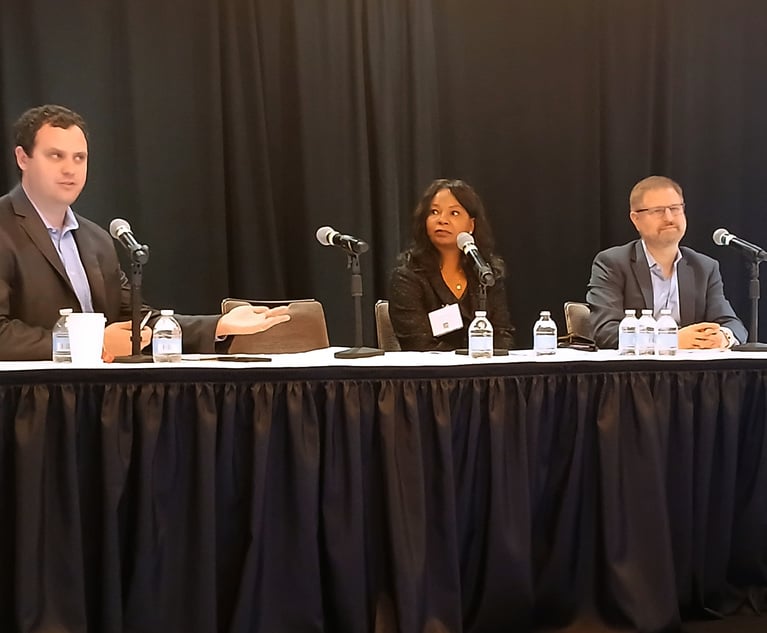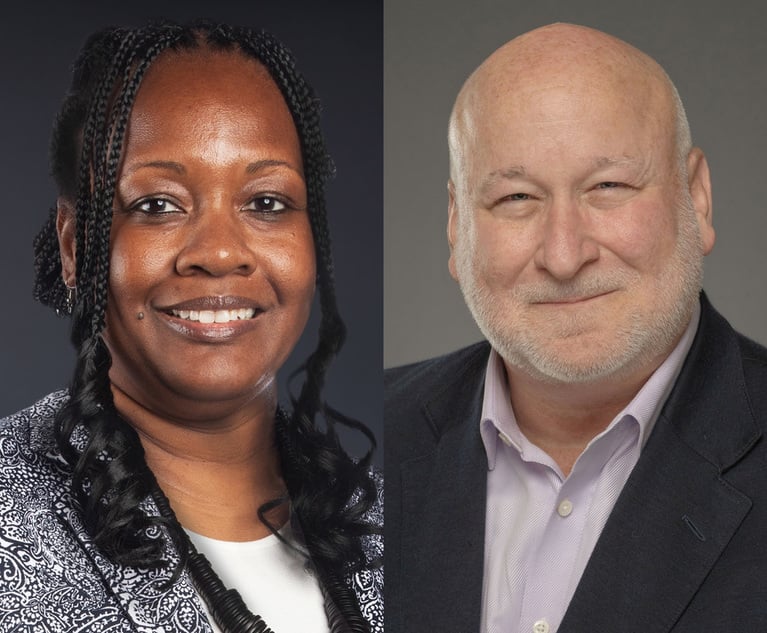Massey Faces West Virginia Fallout
A widow files the first wrongful death suit against the company in the April 5 mine explosion.
April 18, 2010 at 08:00 PM
6 minute read
The original version of this story was published on Law.com
Massey Energy faces its first wrongful death lawsuit stemming from the April 5 explosion at its Upper Big Branch mine in West Virginia that killed 29.
Last Thursday Marlene Griffith sued Massey Energy as well as Performance Coal, the Massey subsidiary that ran the mine, claiming negligence based on working conditions at the mine and a history of safety violations. Griffith is the widow of William Griffith, who was killed in the Upper Big Branch explosion. The AP reports they would have celebrated their 33rd anniversary April 30.
More suits may be forthcoming, if one area law firm gets its way. WSAZ reports that a Raleigh County, W. Va. firm “is raising some eyebrows” after placing ads in local newspapers before all of the miners' funerals had even taken place.
Also last Thursday, institutional investor The Manville Personal Injury Trust sued Massey management to hold them personally accountable for the disaster. The suit names CEO Don Blankenship, former Massey director and Ohio State University President E. Gorden Gee, and four other Massey executives. The trust settled a lawsuit with Massey in 2008 over the company's handling of environmental and safety issues.
An April 16 preliminary report from the Mine Safety and Health Administration (MSHA) found the explosions may have been preventable by using proper ventilation systems and other practices. But who's watching the watchmen? The Labor Department just set up an independent team to carry out an independent review of the MSHA.
A Washington Post analysis on Sunday pointed out the “revolving door” between the the mining industry and the government. “The movement between industry and government allows both to benefit from crucial expertise, but mining safety experts say it often has led to a regulatory system tilted toward coal company interests,” Kimberly Kindy and Dan Eggen report. They identified nearly a dozen former MSHA district directors who have recently taken jobs as executives or consultants with Massey or Massey Energy. The Federal Mine Safety and Health Review Commission, which oversees safety disputes between regulators and operators, has a similar revolving door.
Finally, in light of the tragedy, Ben Heineman Jr. writes Monday for the Atlantic that companies have a business imperative to create and maintain a culture of safety, noting:
“[R]esponsible companies will have a strong commitment to obeying the spirit and letter of existing safety law. They will also establish their own internal rules, beyond what the laws may require, if an additional margin of safety is required to protect employees, consumers, and communities. In my view, such voluntary action avoids catastrophic impact on the company and has benefits for a corporation inside the company, in the marketplace, and in global society.”
Massey Energy faces its first wrongful death lawsuit stemming from the April 5 explosion at its Upper Big Branch mine in West
Last Thursday Marlene Griffith sued Massey Energy as well as Performance Coal, the Massey subsidiary that ran the mine, claiming negligence based on working conditions at the mine and a history of safety violations. Griffith is the widow of William Griffith, who was killed in the Upper Big Branch explosion. The AP reports they would have celebrated their 33rd anniversary April 30.
More suits may be forthcoming, if one area law firm gets its way. WSAZ reports that a Raleigh County, W. Va. firm “is raising some eyebrows” after placing ads in local newspapers before all of the miners' funerals had even taken place.
Also last Thursday, institutional investor The Manville Personal Injury Trust sued Massey management to hold them personally accountable for the disaster. The suit names CEO Don Blankenship, former Massey director and Ohio State University President E. Gorden Gee, and four other Massey executives. The trust settled a lawsuit with Massey in 2008 over the company's handling of environmental and safety issues.
An April 16 preliminary report from the Mine Safety and Health Administration (MSHA) found the explosions may have been preventable by using proper ventilation systems and other practices. But who's watching the watchmen? The Labor Department just set up an independent team to carry out an independent review of the MSHA.
A
Finally, in light of the tragedy, Ben Heineman Jr. writes Monday for the Atlantic that companies have a business imperative to create and maintain a culture of safety, noting:
“[R]esponsible companies will have a strong commitment to obeying the spirit and letter of existing safety law. They will also establish their own internal rules, beyond what the laws may require, if an additional margin of safety is required to protect employees, consumers, and communities. In my view, such voluntary action avoids catastrophic impact on the company and has benefits for a corporation inside the company, in the marketplace, and in global society.”
This content has been archived. It is available through our partners, LexisNexis® and Bloomberg Law.
To view this content, please continue to their sites.
Not a Lexis Subscriber?
Subscribe Now
Not a Bloomberg Law Subscriber?
Subscribe Now
NOT FOR REPRINT
© 2025 ALM Global, LLC, All Rights Reserved. Request academic re-use from www.copyright.com. All other uses, submit a request to [email protected]. For more information visit Asset & Logo Licensing.
You Might Like
View All
Lawyers Drowning in Cases Are Embracing AI Fastest—and Say It's Yielding Better Outcomes for Clients

GC Conference Takeaways: Picking AI Vendors 'a Bit of a Crap Shoot,' Beware of Internal Investigation 'Scope Creep'
8 minute read
Why ACLU's New Legal Director Says It's a 'Good Time to Take the Reins'
Trending Stories
- 1Supreme Court To Review Second Circuit Decision Striking Down 'Deemed Consent' Law Reaching PLO and PA for Making Payments to 'Martyrs' Who Injure or Kill US Nationals
- 2McDermott Adds Covington, Polsinelli Laterals to Build DC Bench
- 3From TAR to Generative AI: A Revolution in Document Review
- 4Legal Tech's Predictions for E-discovery in 2025
- 5Lessons Learned from the Pager Attack: the Law of War, Warfighting, and the Weaponization of the Supply Chain
Who Got The Work
Michael G. Bongiorno, Andrew Scott Dulberg and Elizabeth E. Driscoll from Wilmer Cutler Pickering Hale and Dorr have stepped in to represent Symbotic Inc., an A.I.-enabled technology platform that focuses on increasing supply chain efficiency, and other defendants in a pending shareholder derivative lawsuit. The case, filed Oct. 2 in Massachusetts District Court by the Brown Law Firm on behalf of Stephen Austen, accuses certain officers and directors of misleading investors in regard to Symbotic's potential for margin growth by failing to disclose that the company was not equipped to timely deploy its systems or manage expenses through project delays. The case, assigned to U.S. District Judge Nathaniel M. Gorton, is 1:24-cv-12522, Austen v. Cohen et al.
Who Got The Work
Edmund Polubinski and Marie Killmond of Davis Polk & Wardwell have entered appearances for data platform software development company MongoDB and other defendants in a pending shareholder derivative lawsuit. The action, filed Oct. 7 in New York Southern District Court by the Brown Law Firm, accuses the company's directors and/or officers of falsely expressing confidence in the company’s restructuring of its sales incentive plan and downplaying the severity of decreases in its upfront commitments. The case is 1:24-cv-07594, Roy v. Ittycheria et al.
Who Got The Work
Amy O. Bruchs and Kurt F. Ellison of Michael Best & Friedrich have entered appearances for Epic Systems Corp. in a pending employment discrimination lawsuit. The suit was filed Sept. 7 in Wisconsin Western District Court by Levine Eisberner LLC and Siri & Glimstad on behalf of a project manager who claims that he was wrongfully terminated after applying for a religious exemption to the defendant's COVID-19 vaccine mandate. The case, assigned to U.S. Magistrate Judge Anita Marie Boor, is 3:24-cv-00630, Secker, Nathan v. Epic Systems Corporation.
Who Got The Work
David X. Sullivan, Thomas J. Finn and Gregory A. Hall from McCarter & English have entered appearances for Sunrun Installation Services in a pending civil rights lawsuit. The complaint was filed Sept. 4 in Connecticut District Court by attorney Robert M. Berke on behalf of former employee George Edward Steins, who was arrested and charged with employing an unregistered home improvement salesperson. The complaint alleges that had Sunrun informed the Connecticut Department of Consumer Protection that the plaintiff's employment had ended in 2017 and that he no longer held Sunrun's home improvement contractor license, he would not have been hit with charges, which were dismissed in May 2024. The case, assigned to U.S. District Judge Jeffrey A. Meyer, is 3:24-cv-01423, Steins v. Sunrun, Inc. et al.
Who Got The Work
Greenberg Traurig shareholder Joshua L. Raskin has entered an appearance for boohoo.com UK Ltd. in a pending patent infringement lawsuit. The suit, filed Sept. 3 in Texas Eastern District Court by Rozier Hardt McDonough on behalf of Alto Dynamics, asserts five patents related to an online shopping platform. The case, assigned to U.S. District Judge Rodney Gilstrap, is 2:24-cv-00719, Alto Dynamics, LLC v. boohoo.com UK Limited.
Featured Firms
Law Offices of Gary Martin Hays & Associates, P.C.
(470) 294-1674
Law Offices of Mark E. Salomone
(857) 444-6468
Smith & Hassler
(713) 739-1250







